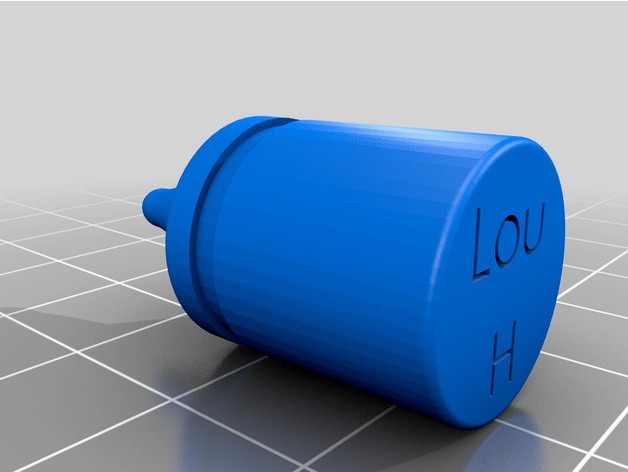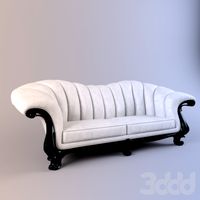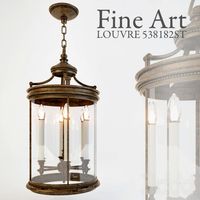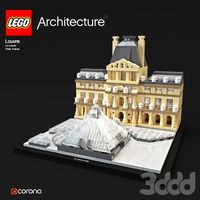Thingiverse

Louvre Aulos by RexConstenla
by Thingiverse
Last crawled date: 3 years ago
Reproduction of the Louvre Aulos (Version 3) :
I've corrected the diameter of the holes (now they're oval as the original), and updated the joints. In the version 2, they're provided with a seat for cork or thread, to ensure a better sealing and avoid leaks as much as possible! But this wasn't enough and, instead I decided to take inspiration from the Classical era auloi (Pydna/Poseidonia) which are made out of many deer bone sections joined with slightly conical spigots. I use ordinary paper on the joints that are slightly loose.
You can check the measurements made and published by Stefan Hagel and compare them to those of your print as a starting point from where you can fine tune the instrument :
https://www.researchgate.net/publication/316277175_Better_understanding_the_Louvre_Aulos
The two pipes (High and Low) of the Louvre Aulos have been modeled and divided in 3 parts (Mouthpiece, Middle and Bell). The lowest note should be between F and F# with a pitch of around 182 Hz, but, depending on the used reeds, the pitch can change.
Good rules are :
The Low pipe should give an octave between its lowest note (all holes closed/stoped) and its highest note (first from top hole open) ¡Without any modification of air pressure or embouchure!
The High pipe with all the holes closed should give the unison with the lowest note of the Low pipe AND opening the first from the top hole of the two pipes, give a perfect fourth (High pipe : b natural (a little bit flat), Low pipe : f# (a little bit flat).
The other internal relations should normally be in tune and can relatively easily be corrected with bee's wax or (sandpaper in this case).
The 3d printable plastic reed I've provided has been removed because the experiments I've ran did not provide reliable enough results and thus are not worth to be downloaded. However, if some of you are interested in continuing the experiment I'll be happy to send you by private e-mail the Solidworks or stl files of the successive 3d printed bocal and blades versions.
Instead, and because there are more and more good aulos reedmakers around the world, I provide here two models of printable reed-former (used while forming/crafting the reed from cane) AND reed-cap (used to protect the reed when non played, a little but like the duduk reeds). Likewise, if you're interested in modify any aspect of these files I'll provide the original Solidworks files if requested by private e-mail or message. Print the formers and caps two by two vertically (the file only have a half of the object) and use the small ridges to tie the two halfs firmly with waxed thread.
There is another file which is a former for the reed tail's inverted cone that enters in the reed-insert of the instrument. They are designed to provide a sort of mold in which the maker can place the hot boiled cane and push step by step. The small obus form inside of the mold has a double function, it prevent's the reed from cracking when pushing it into it's reed-insert former (because the walls of the reed tube are compressed on the two sides) AND, a prevents also the reed from bending because the protruding shape mimics the interior of the reed making it more resistant (some soft reeds tend to bend as they get softer when boiled).
A document on how to prepare the reeds out of cane is in process.
Enjoy and Thank you!
I've corrected the diameter of the holes (now they're oval as the original), and updated the joints. In the version 2, they're provided with a seat for cork or thread, to ensure a better sealing and avoid leaks as much as possible! But this wasn't enough and, instead I decided to take inspiration from the Classical era auloi (Pydna/Poseidonia) which are made out of many deer bone sections joined with slightly conical spigots. I use ordinary paper on the joints that are slightly loose.
You can check the measurements made and published by Stefan Hagel and compare them to those of your print as a starting point from where you can fine tune the instrument :
https://www.researchgate.net/publication/316277175_Better_understanding_the_Louvre_Aulos
The two pipes (High and Low) of the Louvre Aulos have been modeled and divided in 3 parts (Mouthpiece, Middle and Bell). The lowest note should be between F and F# with a pitch of around 182 Hz, but, depending on the used reeds, the pitch can change.
Good rules are :
The Low pipe should give an octave between its lowest note (all holes closed/stoped) and its highest note (first from top hole open) ¡Without any modification of air pressure or embouchure!
The High pipe with all the holes closed should give the unison with the lowest note of the Low pipe AND opening the first from the top hole of the two pipes, give a perfect fourth (High pipe : b natural (a little bit flat), Low pipe : f# (a little bit flat).
The other internal relations should normally be in tune and can relatively easily be corrected with bee's wax or (sandpaper in this case).
The 3d printable plastic reed I've provided has been removed because the experiments I've ran did not provide reliable enough results and thus are not worth to be downloaded. However, if some of you are interested in continuing the experiment I'll be happy to send you by private e-mail the Solidworks or stl files of the successive 3d printed bocal and blades versions.
Instead, and because there are more and more good aulos reedmakers around the world, I provide here two models of printable reed-former (used while forming/crafting the reed from cane) AND reed-cap (used to protect the reed when non played, a little but like the duduk reeds). Likewise, if you're interested in modify any aspect of these files I'll provide the original Solidworks files if requested by private e-mail or message. Print the formers and caps two by two vertically (the file only have a half of the object) and use the small ridges to tie the two halfs firmly with waxed thread.
There is another file which is a former for the reed tail's inverted cone that enters in the reed-insert of the instrument. They are designed to provide a sort of mold in which the maker can place the hot boiled cane and push step by step. The small obus form inside of the mold has a double function, it prevent's the reed from cracking when pushing it into it's reed-insert former (because the walls of the reed tube are compressed on the two sides) AND, a prevents also the reed from bending because the protruding shape mimics the interior of the reed making it more resistant (some soft reeds tend to bend as they get softer when boiled).
A document on how to prepare the reeds out of cane is in process.
Enjoy and Thank you!
Similar models
thingiverse
free

Turnigy 9X Stock Module Mount by dansleeth
...le if you'd like to modify this design in any way. it's a little messy, but i've been as non-destructive as possible.
3dwarehouse
free

organ pipe
...organ pipe
3dwarehouse
huge! you should scale down a little, if you're afraid of heights!
thingiverse
free

Adapter for shower head holder for mounting with zip ties by toasttOriginal
...the pipe is about 27,15 mm, which is about 1,06 inch, width of used zip ties should less or equal to 5 mm.
designed in fusion360.
thingiverse
free

Pipe Organ Reed Pipe by haunebu02
... won't speak correctly. the tongue is secured by a m3 screw. to hold the resonators on top of the pipe i just used some tape.
cg_trader
$4

SCP 173 - In containment | 3D
...d because i wanted to paint them, but you can print them together if you want)
the whole model in intended to be 10~15cm height.
thingiverse
free

Cane Sword by ThatDummGuy
...hole, you can put a cork in it so it doesn't ruin any floors
also i added a dagger in case you want that instead of the sword
thingiverse
free

Lightning shelf by Giovnn
...the structure.
please tell me if there is anything wrong with this project;
hope for the support of the comunity :))
bye, gio.vnn
thingiverse
free

Beat Saber Block/Note by AndreasLyUs
...arrow to the note. there's a little "hole" in the block/note where the arrow should fit perfectly
hope you enjoy :)
thingiverse
free

RMR Offset Picatinny Mount
... for the mounting screw for a #10x32. or whatever screws you feel like using. the pilot holes should print at 0.1" diameter.
thingiverse
free

Barbie sized Cabinet by lichtzeichenanlage
...don't be angry if i upload things which already exists here.
2018/02/21 update: fusion 360 file added because it was missing.
Aulos
3dbaza
$4

Ditre Italia KIM Sofa (103911)
...sofa (103911) 3dbaza ditre italia kim sofa 3d model<br>ditreitalia aulos table 3d model<br>dimensions sofa: 410 * 290 cm<br>unwrap uvw...
thingiverse
free

parametric_recorder_thumbrest by cshapiro
...your current instrument. i set it up for my aulos tenor, which i believe is an a511b. set the...
grabcad
free

COFFEE TABLE PAULO BORGES
...coffee table paulo borges
grabcad
this model is dedicated to my dear friend p aulo borges
c4d stl obj dxf
cg_trader
$10

Ditreitalia KIM sofa
...kim sofa cg trader corner ditreitalia kim sofa 3d aulos corner decor, formats max, obj, mtl, fbx, ready for...
cg_trader
$5

Shawm Woodwind Musical Instrument 3D
...classical music medieval renaissance shawm oboe song sorna rhaita aulos suona sopila zurna shawn .stl stl 3d printer metaverse...
grabcad
free

Van Aardenberg Soprano Recorder Body
...replica of an 18th cent instrument to fit a aulos 503 head joint. the joints are a tight fit...
3dwarehouse
free

aulo tecno
...aulo tecno
3dwarehouse
taller #taller_tecnologia_aula
3dwarehouse
free

ponte na rodovia indio tibiriçá
...ponte na rodovia indio tibiriçá
3dwarehouse
ponte sobre a linha do trem em ribeirão pires são aulo
3dwarehouse
free
![Sokos hotel Viru Viru hotell]](/t/6041865.jpg)
Sokos hotel Viru Viru hotell]
...nd the white material is all made by me. #eesti #estonia #hotel #hotell_viru #sokos_hotel #sokos_hotel_viru #tallinn #viru_hotell
Louvre
turbosquid
$35

Louvre
...
turbosquid
royalty free 3d model louvre for download as 3ds on turbosquid: 3d models for games, architecture, videos. (1208081)
3ddd
$1

louvre
...louvre
3ddd
паркет,текстура
3ddd
$1

Диван Louvre MANTELLASSI Casa Gioiello Louvre
... gioiello
характеристики:с подлокотниками, (3) трехместный, нестандартный
стиль: классический/исторический
3ddd
$1

бра lineatre louvre
... louvre , хрусталь
бра фирмы lineatre коллекция louvre арт. 93010
3ddd
$1

бра lineatre louvre
... louvre , хрусталь
бра фирмы lineatre коллекция louvre арт. 93201
3ddd
free

LINEATRE LOUVRE
...смеситель , lineatre
набор объектов для комплектации ванной комнаты в классическом стиле
turbosquid
$19

biokamino LOUVRE
...e 3d model biokamino louvre for download as max, obj, and fbx on turbosquid: 3d models for games, architecture, videos. (1201471)
3ddd
$1

Fine Art LOUVRE 538182ST
...fine art louvre 538182st
3ddd
fine art lamps , louvre
fine art louvre 538182st
turbosquid
$24

Louvre Mirror
... available on turbo squid, the world's leading provider of digital 3d models for visualization, films, television, and games.
3ddd
$1

LEGO Architecture Louvre
...ddd
lego , конструктор
lego architecture louvre
№ 21024
render - corona
190x175x135mm

